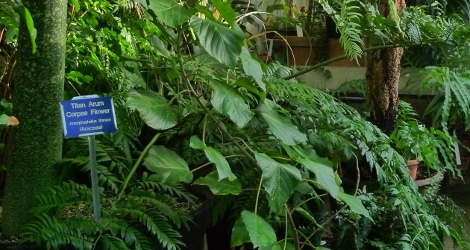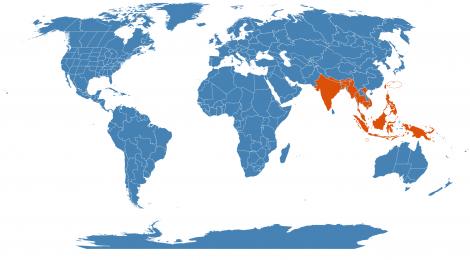Accession Data:
Dioscorea alata L.
- Common Name: Yam, Red Yam, Dagu
- Family: Dioscoreaceae R. Br.
- Description: The red yam is a high-climbing vine with opposite, heart-shaped leaves and a thick, edible underground tuber. The stems are square and winged. The leaf axils often bear small aerial tubers. Male and female flowers occur separately on the branches
- Uses: Edible: This cultivated yam is a popular food item. It is usually boiled and then peeled. The taste is sweet and starchy.
Medicinal: Studies have shown notable Antioxidant Activity, Anti-Fenton Reaction Activity / Copper-chelating and absorbing capability, Bowel function benefits, GI function / Antioxidant, Estrogenic activity, Dioscorin / Angiotensin converting enzyme inhibition / Antihypertensive, Cholesterol lowering, Cytokine-Mimetic property,Disocorin / Cytokine Expression / TLR4-Signaling Pathway, Estrogenic effect in menopausal women, Bone-Protective Effect, Hypo-Triglyceridemic Effect, Renal Protective / Hepatoprotective effects.
From Philippine Alternative Medicine
- IMPORTANT NOTE: Plant Uses are for informational purposes only. EEB Greenhouses assume no responsibility for adverse effects from the use of any plants referred to on this site. Always seek advice from a professional before using any plant medicinally.
- Culture: It is planted at the base of a tree or amidst a network of poles so that it can climb when growing.
- USDA Zone: 11-12
Accession Data:
- Accession # 200000004
- Source: Silander
- Accession Date: 01-10-2000
- Bench: 3206 - DORMANT:South
- Currently: active - needs attention
- Qty: 1 confirmed on 10-03-2018
Classification:
- Division: Magnoliophyta
- Class: Liliopsida
- SubClass: monocots
- Order: Dioscoreales
- SubOrder:
- Family: Dioscoreaceae
- SubFamily:
- Tribe:
- SubTribe:
Flowering Data:
This accession has been observed in bloom on:| Year | Jan | Feb | Mar | Apr | May | Jun | Jul | Aug | Sep | Oct | Nov | Dec | ||||||||||||||||||||||||||||||||||||||||
|---|---|---|---|---|---|---|---|---|---|---|---|---|---|---|---|---|---|---|---|---|---|---|---|---|---|---|---|---|---|---|---|---|---|---|---|---|---|---|---|---|---|---|---|---|---|---|---|---|---|---|---|---|
| 2018 | ||||||||||||||||||||||||||||||||||||||||||||||||||||
| 2017 | ||||||||||||||||||||||||||||||||||||||||||||||||||||
| 2016 | ||||||||||||||||||||||||||||||||||||||||||||||||||||
| 2015 | ||||||||||||||||||||||||||||||||||||||||||||||||||||
| 2014 | ||||||||||||||||||||||||||||||||||||||||||||||||||||
| 2013 | ||||||||||||||||||||||||||||||||||||||||||||||||||||
| 2012 | ||||||||||||||||||||||||||||||||||||||||||||||||||||
| 2011 | ||||||||||||||||||||||||||||||||||||||||||||||||||||
| 2010 | ||||||||||||||||||||||||||||||||||||||||||||||||||||
| 2009 | ||||||||||||||||||||||||||||||||||||||||||||||||||||
| 2008 | ||||||||||||||||||||||||||||||||||||||||||||||||||||
References (internal):
- Medicinal Plants
- Plants with Extrafloral Nectaries
- Edible Plants
- Root Vegetables - Tubers
- EEB 3203 - Developmental Plant Morphology
- Medicinal Plants - Traditional African Medicine
- EEB Greenhouse Holdings native to: Nansei-shoto / Taiwan / Assam / Bangladesh / East Himalaya / India / Nepal / Cambodia / Myanmar / Thailand / Vietnam / Borneo / Jawa / Lesser Sunda Is. / Malaya / Philippines / Sulawesi / Sumatera / Christmas I. / Bismarck Archipelago / New Guinea /
References (external):
- University of Guam Website - last visited 10/02/01
- The Plant List (2013). Version 1.1. Accessed 25 March 2015.
- WCSP (2015). World Checklist of Selected Plant Families. Facilitated by the Royal Botanic Gardens, Kew. Accessed 25 March 2015.
data regenerated on Mon, 24 Dec 2018 14:49:17 -0500 [bcm v4.0]
Images:

Additional images for this accession:
Click on thumbnails to enlargeCurrent Accessions in the Dioscoreaceae
- Dioscorea alata


- Dioscorea bulbifera


- Dioscorea dodecaneura

- Dioscorea elephantipes


- Dioscorea sylvatica
 = indicates flowering in past 14 days
= indicates flowering in past 14 days
 = images available for this accession
= images available for this accession
 = map available for this accession
= map available for this accession
 = accession added within past 90 days
= accession added within past 90 days


